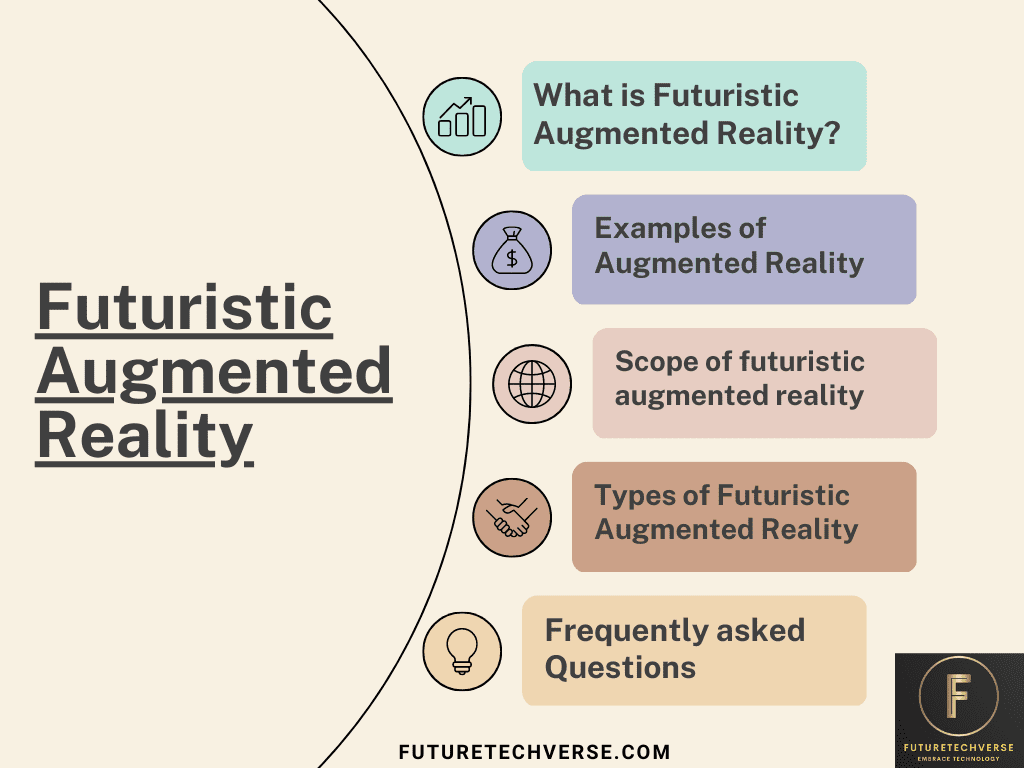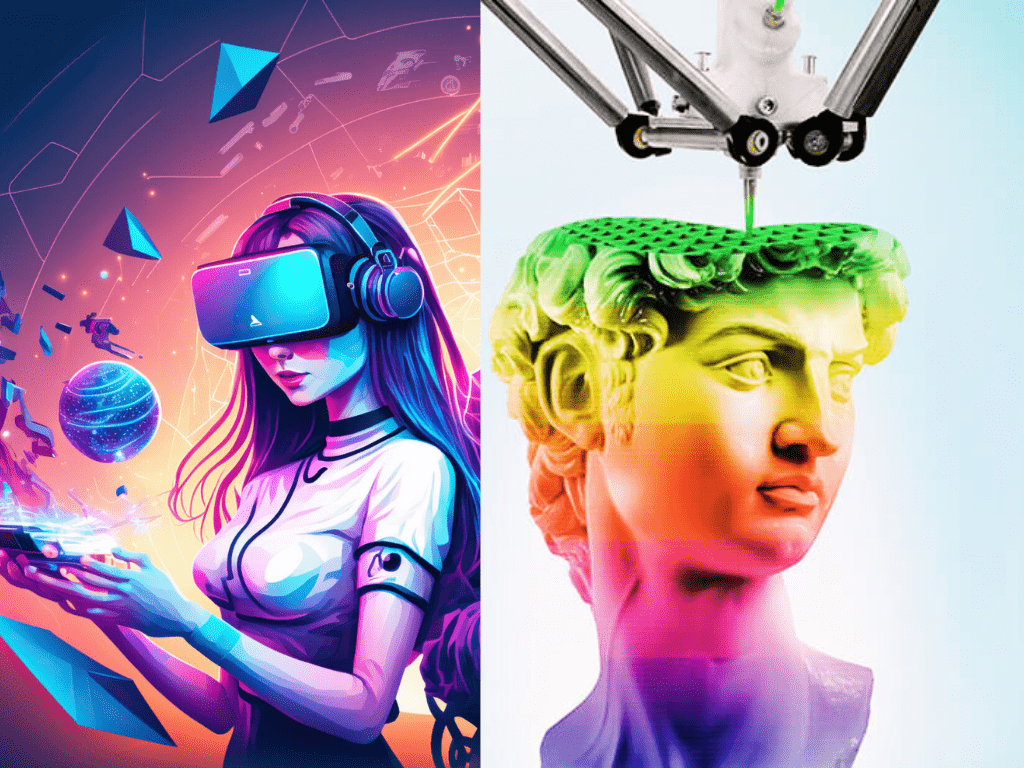The term “futuristic augmented reality” describes an advanced and immersive future vision of augmented reality technology that goes beyond present capabilities in Metaverse.
What is augmented reality? Augmented reality is the future imagines a time when this technology is even more pervasive and connected with our daily lives.
Futuristic Augmented reality (AR) is an enhanced version of the real physical world that is achieved through the use of digital visual elements, sound, or other sensory stimuli delivered via technology.
It is a real-world environment, where objects of the real world are enhanced by computer-generated perceptual information. Buy XREAL Air AR Glasses- Smart Glasses at discounted prices.
Kindly take notice that the affiliate links found in this blog post are exclusively aimed at aiding the upkeep and functioning of this website. My recommendations for products or services are solely based on my belief that they can be beneficial to my readers. Your assistance through these affiliate links is highly valued and enables me to maintain the provision of top-notch content.
Examples of Augmented Reality:
Some examples of futuristic augmented reality could include:
- Pokemon GO
- Ikea Place
- ARLoopa, etc
Augmented reality contact lenses seamlessly blend digital content with our visual field without the need for external devices.
Holographic displays that project interactive, 3D digital content into the real world.
Augmented reality experiences involve multiple senses beyond just sight, such as touch, smell, and sound.
Learn more and stay updated with FutureTechVerse.

What is the scope of futuristic augmented reality?
Futuristic augmented reality (AR) has broad and fascinating scope. We can look forward to the development of new and creative use cases for augmented reality across a range of industries as the technology develops and becomes more seamless and integrated with our daily lives.
Augmented reality for marketing
The use of augmented reality in marketing has the potential to completely change how businesses advertise their goods and services. Utilizing augmented reality (AR) technology, businesses can develop immersive and engaging customer experiences. Customers can, for instance, utilize augmented reality (AR) to virtually try on clothing, visualize how furniture will look in their house, or explore things in 3D before making a purchase.
Augmented reality in healthcare
AR holds great promise for the industry, offering fresh methods for patient care, diagnosis, and treatment. For instance, during surgery, AR can be used to superimpose digital images onto the body of the patient, guiding the surgeon in real-time and increasing accuracy. In order to generate immersive and engaging learning, AR can also be employed in medical education.
Augmented reality in e-commerce
By delivering immersive and interactive product presentations, AR has the potential to improve the customer experience in e-commerce. Customers can, for instance, utilize augmented reality (AR) to virtually try on clothing, visualize how furniture will look in their house, or explore things in 3D before making a purchase.
Augmented reality in the industrial sector
By introducing new design and prototyping tools, AR has the potential to revolutionize the sector. For instance, before making physical prototypes, AR can be used to construct virtual prototypes and test designs in real-world settings. Workers in manufacturing facilities can receive real-time coaching and training thanks to augmented reality.
Sports and Augmented Reality
By delivering real-time data and analysis, AR has the potential to completely change how we watch and engage with sports. As an illustration, real-time statistics and analysis can be shown to viewers by overlapping data onto live broadcasts. Additionally, AR can be applied to training to give athletes realistic, interactive simulations.
Augmented reality for education
Augmented reality (AR) has significant potential in education, providing new tools for interactive and engaging learning experiences. AR can be used in education by Visualizing Complex Concepts, Virtual Field Trips, Interactive Learning Experiences, Language Learning &Training, and Simulations.
What are the different types of Futuristic Augmented Reality?
Although the possibilities for Augmented Reality technology are vast, there are many different types of futuristic augmented reality that we can expect to see in the coming years. Here are some examples:
1. Marker-based AR
Marker-based augmented reality is related to Physical images, or “Markers” moreover 3D Models as well. The back camera of your mobile phone helps to track such Markers. It is also known as Recognition based AR or Image Recognition.
With the aid of AR apps, you can interact with AR content easily within a few seconds. That is the only reason, it is one of the popular types of AR which helps to view objects from different angles.
On rotating your Marker, the 3D imagination also rotates simultaneously. So all you need is to have a marker, through which you can perform augmentation.
2. Markerless AR
The augmentation performed without any marker and scanning the surrounding environment is known to be Markerless augmented reality. This AR will simply detect your plane and perform augmentation of your digital objects. For example Ikea Place.
This type of AR will help you to insert the virtual object or content without moving anything in the background/ plane area. Markerless AR is based on the device’s location, camera, digital compass, and accelerometer which collects positional information. There are a few Mobile apps for the same, which ask users for a flat surface or floor for placing AR objects.
3. Location-based AR
This is one of the most implemented types of augmented reality that is used by users. It primarily depends on GPS, Digital Compass, smartphone cameras, and other technologies to identify the location. Compared to Marker-based AR, it doesn’t require special markers to identify the place where the virtual object is placed.
The digital content is mapped to a specific location. So when the user enters a predetermined location, the objects are displayed on the screen.
Location-based AR doesn’t need any cue from the object to deploy as it can predict from the user’s focus to pair the real-time data with the current location. It also allows developers to showcase creative, interactive, and useful digital content to geographical points of interest in the app. It also adds benefits to travelers to know the whereabouts of any particular area using virtual 3D objects, videos, texts, links, and audio.
4. Superimposition AR
Superimposition AR creates an alternate view of an object and can be used for partial or full replacement of the original view of the object. This means that this technology replaces either the entire view of an object or a portion of it with an augmented view.
In this type of augmented reality, object recognition is highly crucial. In case the app is unable to identify what it is looking at, it will fail to replace the original view with the virtual one. Superimposition AR provides multiple views of a target object with a choice of highlighting the extra relevant information on that object.

5. Projection-based AR
This type of technology is not operated by the user. Projection-based AR is a video projection technique that can extend or deliver digital data by projecting images on the surface of 3D objects or the user’s physical space.
This is one of the most beneficial types of augmented reality that allows users to freely move around the environment within a specified space where the projector and camera are placed. With this technology, it is easy to execute graphical representations with high-definition images or videos that usual lighting techniques cannot show. It can also change the visual shape of the object with the flow of time.
This is an augmented reality software that creates illusions on the basis of the depth, position, and orientation of an object by throwing artificial light onto real flat surfaces under proper guidance to simplify complex manual tasks in businesses. The best part is it wipes out the need for computers and screens as the instructions are placed in a particular task space.
6. Outlining AR
This is another type of augmented reality that identifies the lines and boundaries with an updated augmented view of an object that human eyes cannot recognize. It uses special cameras to perform such actions in certain situations. This technology uses object recognition for a broader understanding of the present environment.
Outlining AR is exclusively used in-car navigation systems for safe driving after sunset times.
To Sum up Futuristic Augmented Reality:
Learn with FutureTechVerse the most amazing art of Futuristic Augmented Reality. In summary, augmented reality (AR) is a rapidly developing technology that has the potential to significantly impact a wide range of sectors and businesses, including marketing, healthcare, education, and manufacturing.
Frequently Asked Questions
How does AR operate?
A device’s camera is used to capture the physical surroundings while displaying digital information on top of it. Typically, computer-generated graphics or images that are programmed to react to user interactions and movements are used to create this digital information.
What are some real-world uses for augmented reality?
AR has a wide range of uses, from gaming and entertainment to healthcare and education. Virtual try-on for apparel and accessories, interactive advertising campaigns, educational aids for visualizing difficult concepts, and medical simulations for teaching healthcare workers are a few examples of AR uses.
What are the advantages of utilizing AR?
AR can offer a variety of advantages, such as higher user engagement, better learning results, increased productivity, and more effective data analysis. Users may engage with digital information in a more natural and intuitive way thanks to AR, which can also provide them with a distinctive and immersive experience.
How is augmented reality used in business?
Marketing and advertising, product design and visualization, staff training and development, and other business applications all make use of augmented reality. Businesses can benefit from AR by getting access to fresh, creative methods to interact with clients, organize work processes, and boost productivity.
Click here to know about Virtual reality.

